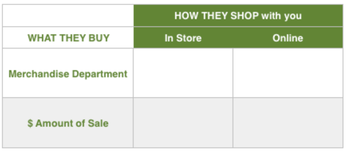It's a given that your sales volume is a very big deal. Granted, you are analyzing it every day. But here's a slightly different approach which you may find very revealing.
Let's start with a couple truisms. The definition of retailing is “selling to the ultimate consumer.”
Retailing also is having "the right product at the right price at the right place at the right time for the right customer."
But, as retailers ponder how best to manage sales in the current consumer environment, does it really matter whether their "right customers" buy from them in-store or online?
Actually, it might! And here’s a simple, free "pilot project" to find out a little more.
Let's start with a couple truisms. The definition of retailing is “selling to the ultimate consumer.”
Retailing also is having "the right product at the right price at the right place at the right time for the right customer."
But, as retailers ponder how best to manage sales in the current consumer environment, does it really matter whether their "right customers" buy from them in-store or online?
Actually, it might! And here’s a simple, free "pilot project" to find out a little more.
A. First, gather your sales data for, say, the past month. Or, depending on your transaction volumes, maybe just a week. This is just a pilot project.
B. Then, using a spreadsheet like the example shown here, enter that sales data into these two categories:
C. Tally it up. For each column of HOW THEY SHOP, tally purchases by merchandise department and dollar volume.
(Remember to look at median values for transactions – half higher, half lower – not just average transaction.)
D. Look for the patterns. And the surprises (yes, there WILL be surprises!) And then, consider what that might mean.
For instance, it may confirm the purposefulness of your shoppers. They have a clear idea of what to buy from you online, and what they prefer to buy in-store.
Or, maybe it will illustrate how you have two very different kinds of shoppers. Here's what that might mean:
Fun, isn't it? We think this exercise will stimulate your merchant thinking. And that of your key staff people as well.
Managing sales is such a big deal for retailers. And you really cannot know too much about where sales are coming from, and why. The art of being a merchant is enhanced by exercises like this.
We're big on the old saw, "Retailers need to work smarter, not harder."
B. Then, using a spreadsheet like the example shown here, enter that sales data into these two categories:
- HOW THEY SHOP with you: In-Store or Online
- WHAT THEY BUY from you, both the merchandise department and what they paid.
C. Tally it up. For each column of HOW THEY SHOP, tally purchases by merchandise department and dollar volume.
(Remember to look at median values for transactions – half higher, half lower – not just average transaction.)
D. Look for the patterns. And the surprises (yes, there WILL be surprises!) And then, consider what that might mean.
For instance, it may confirm the purposefulness of your shoppers. They have a clear idea of what to buy from you online, and what they prefer to buy in-store.
Or, maybe it will illustrate how you have two very different kinds of shoppers. Here's what that might mean:
- Do they demand/deserve different merchandise mixes?
- What will it take to grow sales from each group?
- Should one group have priority over the other?
- Will you need other vendors?
- Different marketing programs?
- Or…? Or…?
Fun, isn't it? We think this exercise will stimulate your merchant thinking. And that of your key staff people as well.
Managing sales is such a big deal for retailers. And you really cannot know too much about where sales are coming from, and why. The art of being a merchant is enhanced by exercises like this.
We're big on the old saw, "Retailers need to work smarter, not harder."

